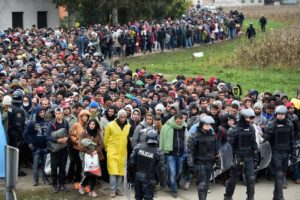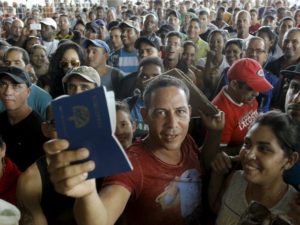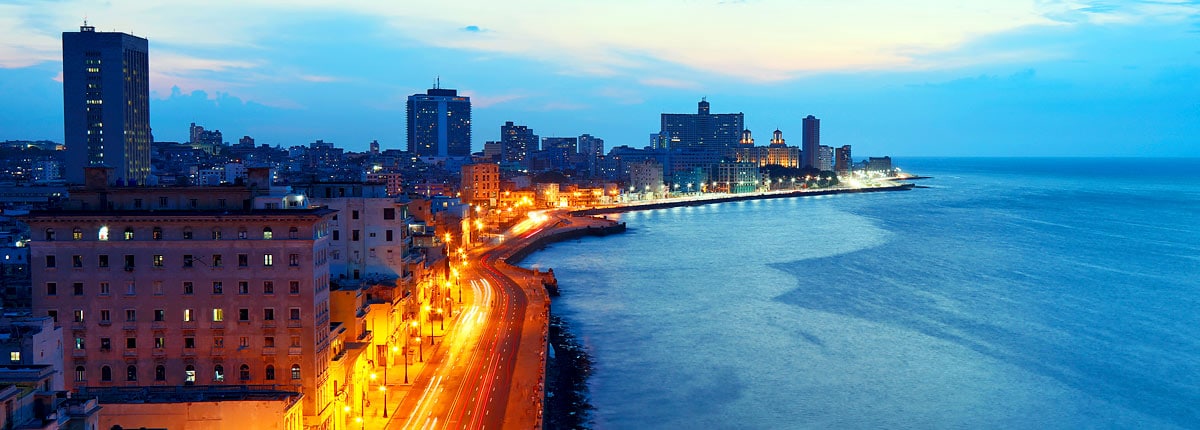 EL HOY LARGO CAMINO CUBANO POR ALCANZAR “EL SUEÑO AMERICANO”.
EL HOY LARGO CAMINO CUBANO POR ALCANZAR “EL SUEÑO AMERICANO”.
En los primeros cinco meses del presente año fiscal, 6,289 cubanos acudieron a los puertos de entrada en la frontera entre Estados Unidos y México sin documentos. La cifra se encamina a casi duplicar el total para todo el año fiscal 2018, según datos de Aduanas y Protección Fronteriza de Estados Unidos.
Si bien los cubanos generalmente tienen más posibilidades de recibir asilo que los centroamericanos porque sus historias de persecución política son a menudo más claras, el éxito no está asegurado, dijo Allen, quien estima que sólo del 20 al 30 por ciento de sus clientes cubanos ganarán sus casos.
No obstante, ese mensaje no ha llegado a los cubanos que permanecen en Ciudad Juárez, muchos de los cuales tuvieron que vender sus vehículos, negocios u hogares para financiar el viaje.
“Dicen que nosotros tenemos la prioridad, que nos reciben de una forma u otra. Siempre nos reciben”, comentó Rojas, quien vendió casi la mitad de su ganado. “Ellos siempre nos aceptan”, afirmó.
Una nueva ruta
Los cubanos que tienen la suerte de obtener una visa estadounidense -para visitar a un familiar, por ejemplo- pueden volar hasta allí legalmente y tienen la posibilidad de solicitar la residencia después de un año en Estados Unidos. Para la mayoría, sin embargo, llegar a ese país no es fácil.
Incluso antes de que terminara la política de “pies secos, pies mojados”, los cubanos comenzaron a forjar nuevas rutas, volando a países de América Central y del Sur con requisitos de visa más laxos para luego ir al norte. Solo pocos países, como Guyana, no requieren visas para los cubanos.
El año pasado, Panamá facilitó el ingreso de los cubanos para hacer compras, creando otra vía para que algunos de ellos llegaran a Centroamérica.
Arasay Sánchez, una mujer de 33 años, dijo que un día estaba navegando por Internet en un parque cuando vio una historia sobre las caravanas. Después de vender su casa y la mayoría de sus pertenencias, viajó a Panamá el 25 de enero.
Confió en una guía de siete páginas que heredó de otros cubanos que habían viajado a Estados Unidos y que detallaba todo, desde dónde dormir hasta dónde comprar un teléfono.
La ruta terminó en Ciudad Juárez, vista por muchos cubanos como un lugar más seguro y ordenado para buscar asilo que otros cruces fronterizos mexicanos más concurridos, a pesar de su reputación como una de las ciudades más violentas del mundo. Ubicada al sur de El Paso, Texas, la ciudad recibió relativamente pocos solicitantes de asilo hasta fines del 2018.
Muchos están consternados por la larga espera que encuentran, dijeron directores de refugios, y están cada vez más preocupados por la seguridad, después de que surgieron reportes sobre desapariciones de cubanos en México. Pocos abandonan los refugios, dijeron 10 migrantes entrevistados.
Sánchez y su pareja llegaron a Ciudad Juárez en febrero y se han mudado de un refugio a otro luchando con la comida picante mexicana. “Hasta los caramelos (tienen chile)”, dijo mientras agarraba los pliegues de sus jeans para demostrar que había perdido peso.
Los expertos no creen que el flujo de migrantes cubanos vaya a disminuir pronto. Obama hizo más fácil para los estadounidenses viajar a la isla, generando nuevos negocios. Pero ese dinero se agotó después de que Trump endureció las reglas, dijo Pedro Freyre, un abogado que estudia la relación entre Estados Unidos y Cuba.
Llegar a Estados Unidos pondría una larga odisea para Reinaldo Ramírez, un contratista de construcción de 51 años de Jagüey Grande. A partir de 2006, intentó llegar a Estados Unidos siete veces en lancha, incluido el día en que Obama canceló la política migratoria de “pies secos, pies mojados”.
La nueva ruta ha sido igual de ardua. Después de volar a Guyana en septiembre, Ramírez y su esposa tuvieron que caminar por la región de Darién, un tramo de jungla entre Panamá y Colombia. Después de cruzar la primera vez, las autoridades panameñas los deportaron a Colombia, obligándolos a repetir la caminata.
Luego de llegar a Ciudad Juárez en medio de cientos de solicitantes de asilo, Ramírez siente que está más cerca. “Casi tengo logrado mi objetivo y mi sueño americano”, dijo.
 TODAY CUBANS LONG WAY TO ACHIEVE “THE AMERICAN DREAM”.
TODAY CUBANS LONG WAY TO ACHIEVE “THE AMERICAN DREAM”.
In the first five months of this fiscal year, 6,289 Cubans went to the ports of entry on the United States-Mexico border without documents. The figure is headed to almost double the total for the entire fiscal year 2018, according to data from US Customs and Border Protection.
While Cubans are generally more likely to receive asylum than Central Americans because their stories of political persecution are often clearer, success is not assured, said Allen, who estimates that only 20 to 30 percent of his Cuban clients will win. their cases.
However, that message has not reached the Cubans who remain in Ciudad Juárez, many of whom had to sell their vehicles, businesses or homes to finance the trip.
“They say that we have the priority, that they receive us in one way or another, they always receive us,” said Rojas, who sold almost half of his cattle. “They always accept us,” he said.
A new route
Cubans who are fortunate enough to obtain a US visa – to visit a relative, for example – can fly there legally and have the possibility of applying for residency after one year in the United States. For most, however, getting to that country is not easy.
Even before the policy of “dry feet, wet feet” ended, Cubans began to forge new routes, flying to countries in Central and South America with more lax visa requirements to then go north. Only a few countries, such as Guyana, do not require visas for Cubans.
Last year, Panama facilitated the entry of Cubans to make purchases, creating another way for some of them to reach Central America.
Arasay Sánchez, a 33-year-old woman, said that one day she was surfing the Internet in a park when she saw a story about the caravans. After selling his house and most of his belongings, he traveled to Panama on January 25.
He trusted a seven-page guide that he inherited from other Cubans who had traveled to the United States and detailed everything from where to sleep to where to buy a telephone.
The route ended in Ciudad Juárez, seen by many Cubans as a safer and more orderly place to seek asylum than other, more crowded Mexican border crossings, despite its reputation as one of the most violent cities in the world. Located south of El Paso, Texas, the city received relatively few asylum seekers until the end of 2018.
Many are dismayed by the long wait they encounter, said shelter directors, and are increasingly concerned about security, after reports surfaced of disappearances of Cubans in Mexico. Few people leave shelters, said 10 migrants interviewed.
Sanchez and his partner arrived in Ciudad Juarez in February and have moved from one refuge to another, struggling with spicy Mexican food. “Even the candy (they have chili),” he said as he grabbed the folds of his jeans to show that he had lost weight.
Experts do not believe that the flow of Cuban migrants will soon diminish. Obama made it easier for Americans to travel to the island, generating new business. But that money ran out after Trump toughened the rules, said Pedro Freyre, a lawyer who studies the relationship between the United States and Cuba.
Arriving in the United States would set a long odyssey for Reinaldo Ramírez, a 51-year-old construction contractor for Jagüey Grande. As of 2006, he tried to reach the United States seven times by boat, including the day that Obama canceled the migration policy of “dry feet, wet feet”.
The new route has been equally arduous. After flying to Guyana in September, Ramírez and his wife had to walk through the Darien region, a stretch of jungle between Panama and Colombia. After crossing the first time, the Panamanian authorities deported them to Colombia, forcing them to repeat the walk.
After arriving in Ciudad Juárez amidst hundreds of asylum seekers, Ramírez feels he is closer. “I have almost achieved my goal and my American dream,” he said.
Agencies/ CiberCuba/ Extractos/ José L. González/ Lizbeth Diaz/ Sarah Marsh/ Kristina Cooke/ Yeganeh Torbati/ Internet Photos/ Arnoldo Varona/ www.TheCubanHistory.com
THE CUBAN HISTORY, HOLLYWOOD.



 < TODAY CUBANS Long Way To Achieve "THE AMERICAN DREAM".
< TODAY CUBANS Long Way To Achieve "THE AMERICAN DREAM".





